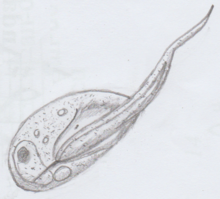
Back لاقدميات Arabic لاقدميات ARZ Apusozoa Bulgarian Apusozous Catalan Apusozoa Czech Apusozoa Spanish بیپازیان Persian Apusozoa French Apusozoa Irish Apusozoos Galician
| Apusozoa | |
|---|---|

| |
| Apusomonas sp. | |
| Scientific classification (obsolete)
| |
| Domain: | Eukaryota |
| Clade: | Amorphea |
| Clade: | Obazoa |
| Phylum: | Apusozoa Cavalier-Smith 1997 emend. 2013 |
| Groups included | |
| Cladistically included but traditionally excluded taxa | |
The Apusozoa are a paraphyletic phylum[1] of flagellate eukaryotes. They are usually around 5–20 μm in size, and occur in soils and aquatic habitats, where they feed on bacteria. They are grouped together based on the presence of an organic shell or theca under the dorsal surface of the cell.
The name derives from the Ancient Greek words for footless (ἄπους) and animal (ζῷον).[2][3]
This phylum is currently defined as containing the Breviata and the Apusomonadida.[4][5] However, it currently usually is viewed as paraphyletic, with the Breviata as more basal. The opisthokonts appear to have emerged as sister of the apusomonadida. It has been suggested that the Mantamonadida be classified in Apusozoa.[6][7]
The ancyromonadida appear to be Varisulca, Planomonadida, shifting them possibly more basal than the Amoebozoa,[8][9][10] or less basal.[11] While some classification systems have placed Hemimastigida in Apusozoa,[12] 2018 research indicated that hemimastigotes (Hemimastix kukwesjijk/Hemimastix/Spironemidae) are their own supra-kingdom.[13]
- ^ Cavalier-Smith T, Chao EE, Stechmann A, Oates B, Nikolaev S (October 2008). "Planomonadida ord. nov. (Apusozoa): ultrastructural affinity with Micronuclearia podoventralis and deep divergences within Planomonas gen. nov". Protist. 159 (4): 535–62. doi:10.1016/j.protis.2008.06.002. PMID 18723395.
- ^ ἄπους. Liddell, Henry George; Scott, Robert; A Greek–English Lexicon at the Perseus Project
- ^ ζῷον. Liddell, Henry George; Scott, Robert; A Greek–English Lexicon at the Perseus Project
- ^ Eme, Laura; Sharpe, Susan C.; Brown, Matthew W.; Roger, Andrew J. (2014-08-01). "On the Age of Eukaryotes: Evaluating Evidence from Fossils and Molecular Clocks". Cold Spring Harbor Perspectives in Biology. 6 (8): a016139. doi:10.1101/cshperspect.a016139. ISSN 1943-0264. PMC 4107988. PMID 25085908.
- ^ Ruggiero, Michael A.; Gordon, Dennis P.; Orrell, Thomas M.; Bailly, Nicolas; Bourgoin, Thierry; Brusca, Richard C.; Cavalier-Smith, Thomas; Guiry, Michael D.; Kirk, Paul M. (2015-06-11). "Correction: A Higher Level Classification of All Living Organisms". PLOS ONE. 10 (6): e0130114. Bibcode:2015PLoSO..1030114R. doi:10.1371/journal.pone.0130114. ISSN 1932-6203. PMC 5159126. PMID 26068874.
- ^ Glücksman E, Snell EA, Berney C, Chao EE, Bass D, Cavalier-Smith T (September 2010). "The Novel Marine Gliding Zooflagellate Genus Mantamonas (Mantamonadida ord. n.: Apusozoa)". Protist. 162 (2): 207–221. doi:10.1016/j.protis.2010.06.004. PMID 20884290.
- ^ Orr, Russell J. S.; Zhao, Sen; Klaveness, Dag; Yabuki, Akinori; Ikeda, Keiji; Makoto, Watanabe M.; Shalchian-Tabrizi, Kamran (2017-10-08). "Enigmatic Diphyllatea eukaryotes: Culturing and targeted PacBio RS amplicon sequencing reveals a higher order taxonomic diversity and global distribution". bioRxiv 10.1101/199125.
- ^ Speijer, Dave; Lukeš, Julius; Eliáš, Marek (2015-07-21). "Sex is a ubiquitous, ancient, and inherent attribute of eukaryotic life". Proceedings of the National Academy of Sciences. 112 (29): 8827–8834. Bibcode:2015PNAS..112.8827S. doi:10.1073/pnas.1501725112. ISSN 0027-8424. PMC 4517231. PMID 26195746.
- ^ Torruella, Guifré; Mendoza, Alex de; Grau-Bové, Xavier; Antó, Meritxell; Chaplin, Mark A.; Campo, Javier del; Eme, Laura; Pérez-Cordón, Gregorio; Whipps, Christopher M. (2015). "Phylogenomics Reveals Convergent Evolution of Lifestyles in Close Relatives of Animals and Fungi". Current Biology. 25 (18): 2404–2410. doi:10.1016/j.cub.2015.07.053. PMID 26365255.
- ^ Cavalier-Smith, Thomas; Chao, Ema E.; Snell, Elizabeth A.; Berney, Cédric; Fiore-Donno, Anna Maria; Lewis, Rhodri (2014). "Multigene eukaryote phylogeny reveals the likely protozoan ancestors of opisthokonts (animals, fungi, choanozoans) and Amoebozoa". Molecular Phylogenetics and Evolution. 81: 71–85. doi:10.1016/j.ympev.2014.08.012. PMID 25152275.
- ^ Paps, Jordi; Medina-Chacón, Luis A.; Marshall, Wyth; Suga, Hiroshi; Ruiz-Trillo, Iñaki (2013). "Molecular Phylogeny of Unikonts: New Insights into the Position of Apusomonads and Ancyromonads and the Internal Relationships of Opisthokonts". Protist. 164 (1): 2–12. doi:10.1016/j.protis.2012.09.002. PMC 4342546. PMID 23083534.
- ^ Cavalier-Smith, Thomas (2003-01-01). "Protist phylogeny and the high-level classification of Protozoa". European Journal of Protistology. 39 (4): 338–348. doi:10.1078/0932-4739-00002. ISSN 0932-4739.
- ^ Chung, Emily (November 16, 2018). "Rare microbes lead scientists to discover new branch on the tree of life". CBC news. Retrieved 16 November 2018.
© MMXXIII Rich X Search. We shall prevail. All rights reserved. Rich X Search